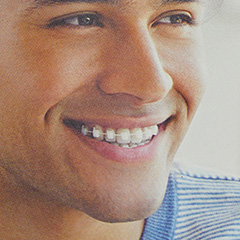Orthodontics can be defined as the art of aligning teeth. Devices to move the teeth go all the way back to Etruscan and Roman civilizations...
A brief history of
Orthodontics key dates
- Late XIXth century and early XXth: emergence of fixed appliances, mostly in the US. Only in the early 60s did these start to appear in Europe.
- 70s: braces, which are glued directly onto the teeth, graduately take over the bands (rings that were sealed around the teeth).
- 80s: significant development of new titanium-based alloys enable the use of lighter and more consistent forces on the teeth.
- Early 2000s: self-ligating braces gradually replace conventional braces ; the absence of ligatures helps minimize potential bacterial flora and contributes to reduce friction with the wire, further allowing a decrease in the forces applied to the teeth. We have been using self-ligating braces in our practice almost exclusively since 2010.
HOW DOES ONE EXPLAIN DENTAL MOTION?
Throughout life, teeth move through a physiological bone apposition-resorption mechanism. Orthodontics only amplify this physiological motion by exerting forces on the teeth.
WHAT IS THE DIFFERENCE WITH DENTOFACIAL ORTHOPEDICS (DFO)?
Dentofacial Orthopedics act on bone structure and not just on the teeth, relying on the growth potential of young patients.
They require appliances that can be isolated: mandibular growth activators -- removable (to be worn at night) or fixed --, palatal expanders...
WHAT ARE THE GOALS OF ORTHODONTICS AND DFO?
Although aesthetics are an obvious goal, one cannot underestimate the functional goals of orthodontics.
Good harmony between the upper and lower teeth prevents possible temporomandibular joint disorders (teeth-chattering, pain while opening up one’s mouth, meniscal lesions) and tooth-supporting tissues (gingivitis, periodontitis, gingival recession).
IMPORTANCE OF ORO-FACIAL FUNCTIONS UNDERLYING DYSMORPHOSES

Because of the genetic independence between bone and teeth, most of the dysmorphoses that we treat have a hereditary origin. But oro-facial functions also play an important role:
- Breathing: oral breathing causes low positionning of the tongue that can disrupt the growth of facial bones. In this case, an ENT check-up may be necessary.
- Swallowing: If the tongue is not positioned against the palate (behind the upper incisors) while swallowing, there can often be found a gap between the maxilla and the mandible in the anteroposterior or vertical direction (open bite).
Correcting this dysfunction is essential to obtain satisfying and stable results with the orthodontic treatment.
Sessions with a speech therapist and / or wearing a small device 15 to 20 minutes per day for a few months can usually restore a correct position of the tongue.
DIFFERENT TYPES OF ORTHODONTIC APPLIANCES

The emergence of fixed appliances (multi-brackets) in the early twentieth century have truly revolutionized orthodontics.
They allow for minor tooth movement of great precision in all three directions of space with translational motions -- it is not limited to versions, as it used to be with removable appliances.
The arch wire, engaged in the brackets, is what causes tooth movement. Noadays, we have a very wide range of wires that differ in their section, size and especially in the kind of alloy that they are made of. The nickel-titanium arch wires exert very weak and almost constant forces in-between appointments.
 These fixed appliances can also be very discreet when the brackets are made of ceramic.
These fixed appliances can also be very discreet when the brackets are made of ceramic.
We always use the most adapted treatment to each type of malocclusion.
ADULT ORTHODONTICS
The induced tooth movement is not reduced to the patient’s age. Thus the possibility of orthodontic treatment for adults -- which has become more and more common.
The emergence and improvement of ceramic brackets make it possible today to carry out discreet treatments.
There is however a fundamental difference with the treatment of children and adolescents : adults are not growing patients, therefore dento-facial orthopedics that act on bone structure are not possible.
When the gap between the maxillary and the mandible is too great, it is necessary to associate a surgical intervention with the orthodontic treatment. The first step is aligning the teeth through orthodontic treatment, and only then surgery can be performed. Afterwards, another few months of orthodontic treatment are required.
These treatments that combine orthodontics and surgery most often give excellent results, both aesthetic and functional.